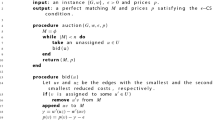Abstract
The auction algorithm is a parallel relaxation method for solving the classical assignment problem. It resembles a competitive bidding process whereby unassigned persons bid simultaneously for objects, thereby raising their prices. Once all bids are in, objects are awarded to the highest bidder. This paper generalizes the auction algorithm to solve linear transportation problems. The idea is to convert the transportation problem into an assignment problem, and then to modify the auction algorithm to exploit the special structure of this problem. Computational results show that this modified version of the auction algorithm is very efficient for certain types of transportation problems.
Similar content being viewed by others
References
M.L. Balinski, A competitive (dual) simplex method for the assignment problem, Math. Progr. 34(1986)125.
R. Barr, F. Glover and D. Klingman, The alternating basis algorithm for assignment problems, Math. Progr. 13(1977)1.
D.P. Bertsekas, A distributed algorithm for the assignment problem, Laboratory for Information and Decision Systems Unpublished Report, M.I.T. (March 1979).
D.P. Bertsekas, A new algorithm for the assignment problem, Math. Progr. 21(1981)152.
D.P. Bertsekas, A unified framework for primal-dual methods in minimum cost network flow problems, Math. Progr. 32(1985)125.
D.P. Bertsekas, Distributed asynchronous relaxation methods for linear network flow problems, LIDS Report P-1601, M.I.T. (Sept. 1986; revised Nov. 1986).
D.P. Bertsekas, Distributed relaxation methods for linear network flow problem,Proc. 25th IEEE Conf. on Decision and Control, Athens, Greece (1986) pp. 2101–2106.
D.P. Bertsekas, The auction algorithm: A distributed relaxation method for the assignment problem, LIDS Report P-1653, M.I.T. (March 1987); Also in: Ann. Oper. Res. 14(1988)105.
D.P. Bertsekas and J. Eckstein, Distributed asynchronous relaxation methods for linear network flow problems,Proc. IFAC '87, Munich, Germany (July 1987).
D.P. Bertsekas and J. Eckstein, Dual coordinate step methods for linear network flow problems, Math. Progr. Series B 42(1988)203.
D.P. Bertsekas and P. Tseng, Relaxation methods for minimum cost ordinary and generalized network flow problems, LIDS Report P-1462, M.I.T. (May 1985); Oper. Res. 36(1988)93.
D.P. Bertsekas and P. Tseng, RELAX: A code for linear network flow problems, in:FORTRAN Codes for Network Optimization, ed. B. Simeone et al., Ann. Oper. Res. 13 (1988)125.
D.P. Bertsekas and J.N. Tsitsiklis,Parallel and Distributed Computation: Numerical Methods (Prentice-Hall, Englewood Cliffs, NJ, 1989).
M. Engquist, A successive shortest path algorithm for the assignment problem, INFOR 20 (1982)370.
F. Glover, R. Glover and D. Klingman, Threshold assignment algorithm, Center for Business Decision Analysis Report CBDA 107, Graduate School of Business, University of Texas at Austin (Sept. 1982).
A.V. Goldberg, Solving minimum-cost flow problems by successive approximations, extended abstract, submitted to STOC 87, Nov. 1986.
A.V. Goldberg and R.E. Tarjan, Solving minimum cost flow problems by successive approximation,Proc. 19th ACM STOC (May, 1987).
D. Goldfarb, Efficient dual simplex methods for the assignment problem, Math. Progr. 33(1985)187.
M. Hung, A polynomial simplex method for the assignment problem, Oper. Res. 31(1983) 595.
R. Jonker and A. Volgenant, A shortest augmenting path algorithm for dense and sparse linear assignment problems, Computing 28(1987)325.
J. Kennington and R. Helgason,Algorithms for Network Programming (Wiley, New York, 1980).
D. Klingman, A. Napier and J. Stutz, NETGEN — A program for generating large scale (un)capacitated assignment, trasnportation, and minimum cost flow network problems, Management Science 20(1974)814.
H.W. Kuhn, The Hungarian method for the assignment problem, Naval Research Logistics Quarterly 2(1955)83.
L.F. McGinnis, Implementation and testing of a primal-dual algorithm for the assignment problem, Oper. Res. 31(1983)277.
C.H. Papadimitriou and K. Steiglitz,Combinatorial Optimization: Algorithms and Complexity (Prentice-Hall, Englewood Cliffs, NJ, 1982).
R.T. Rockafellar,Network Flows and Monotropic Programming (Wiley, New York, 1984).
Author information
Authors and Affiliations
Rights and permissions
About this article
Cite this article
Bertsekas, D.P., Castanon, D.A. The auction algorithm for the transportation problem. Ann Oper Res 20, 67–96 (1989). https://doi.org/10.1007/BF02216923
Issue Date:
DOI: https://doi.org/10.1007/BF02216923




